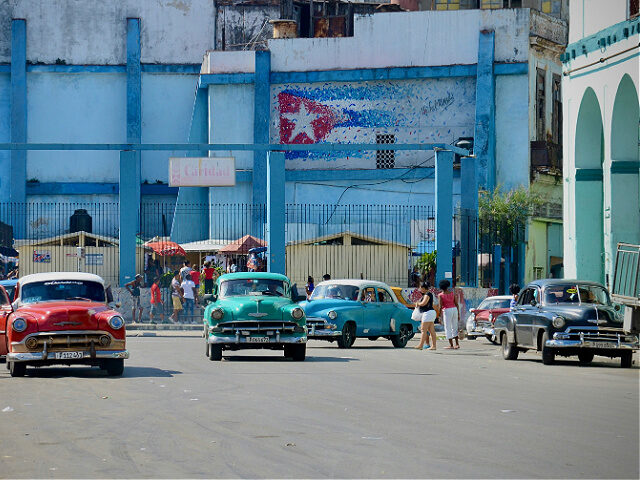Cubans in Havana are increasingly resorting to using Chinese electric motorbikes, the South China Morning Post (SCMP) reported on Monday, as the decrepit “classic” vehicles tourists fawn over become increasingly less reliable and the Communist Party fails to keep gasoline and diesel fuel stocked.
After 65 years of communist rule repressing natural economic activity, blocking access to the U.S. market, and replacing the nation’s educated class with poorly prepared regime elites, Cuba’s power grid is potentially more unreliable than its old cars, making electric vehicles (EVs) a gamble. Once the wealthiest country in Latin America, Cuba now endures regular blackouts — and nationwide collapses of the power grid are not unheard of — as a result of the ruling Castro family regime neglecting to maintain any sector of Cuba’s infrastructure.
While the Morning Post depicted the rise of EVs as a viable solution to fuel shortages and the communist economic crisis, tens of thousands of EVs relying on the power grid to function will likely impose significant strain on the fragile power grid, leading to more electrical failures and the increasingly common protests accompanying them.
The rising presence of EVs in Cuba is largely the result of its close relationship with China. The Morning Post highlighted one especially productive joint venture, an electric motorbike factory owned by the Chinese company Tianjin Dongxing Industrial and the Castro regime. The regime participates in the manufacturing through one of its many corporate entities, “Caribbean Electric Vehicles” (Vedca), which it co-owns with Tianjin Dongxing.
Reuters, which originally ran the feature on Vedca in July, reported that “between 2020 and 2022, the last year for which figures are available, Cuba-based companies produced more than 23,000 electric vehicles.” Those numbers were described as “official” data, meaning they are, like all other Cuban government statistics, subject to regime fabrications. The official newspaper of the Cuban Communist Party, Granma, indeed published the statistic in February 2023.
As of July, Reuters reported that refueling a car in Cuba could take hours or days on occasion, and “a five-fold price hike earlier this year means a typical 40-liter tank of gas costs more than a state-worker’s average monthly wage, far out of reach for most.” This has led to the adoption of EVs, with no apparent plan for dramatically expanding electricity supply. In far less vulnerable power grids — such as California — governments have resorted to ordering residents not to charge electric vehicles when energy demand soars due to weather or other factors.
The Cuban venture with Tianjin Dongxing is years in the making. The Chinese state-run Xinhua News Agency reported in March 2023 that the electric motorbikes were part of a larger trend of massive Chinese investment into Cuba, one of the world’s least favorable national markets.
“In recent years, China’s new energy vehicle industry has developed rapidly, while Cuba is also vigorously promoting energy conservation and emission reduction, addressing energy shortages and environmental pollution. Therefore, both sides have common goals,” Wei Yunpu, Chairman of Tianjin Dongxing, told Xinhua at the time.
“It is an important joint venture project in the manufacturing industry between China and Cuba. Among them, the Chinese side invests in equipment, technology, decoration, materials, etc.,” while the ancient side is mainly responsible for assembly.
China has for decades maintained friendly relations with Cuba as a result of their shared repressive ideology. Commercially, however, the relationship has struggled in part due to the Cuban government’s inability to offer much of value. Figurehead President Miguel Díaz-Canel attempted to change this dynamic in 2018 by announcing the regime’s intention to join the Belt and Road Initiative (BRI), a Chinese global infrastructure program in which Beijing offered impoverished countries unpayable loans later used to control that country’s geopolitical behavior. The original intent of the BRI was to reconstruct the Ancient Silk Road, the legendary trade route once connecting eastern China to western Europe. Dictator Xi Jinping has dramatically expanded the scope of the project deep into sub-Saharan Africa, southern Asia, and Latin America.
Less than a year after Díaz-Canel expressed Cuba’s intent to join the BRI, China began touting its role in improving travel in the country, shipping Chinese-built train cars to be used on the Havana-Santiago de Cuba railway. The Castro regime did not formally sign a BRI document until 2021, however, when it joined an “energy alliance” reportedly intended to help the regime develop its energy infrastructure.
Cuba’s energy infrastructure is in shambles. Daily blackouts were a regular occurrence already when the “energy alliance” deal broke. The Communist Party has also failed to maintain functional infrastructure to refine, store, and distribute gasoline and diesel. Cuba has four oil refineries, three of them built before 1959. The newest still-operating refinery was built with the help of the Soviet Union in the 1980s. In a sign of the poor state of the oil infrastructure in the country, a massive fire consumed an oil depot complex in Matanzas, north-central Cuba, in 2022, prompting the government to evacuate over 4,000 people and permanently destroying fuel tankers and other storage necessities.
The government of Russia announced plans to build a new refinery in Cuba in July, potentially giving it a project that both Moscow and Havana could jointly collaborate with alongside the socialist government of Venezuela, home to the world’s largest known oil reserves. The Castro regime relied on Venezuelan oil for years during the rule of late dictator Hugo Chávez, but Venezuela was forced to reduce its exports to Cuba as the socialist system led to the full collapse of Venezuela’s economy, beginning around 2014.

COMMENTS
Please let us know if you're having issues with commenting.